by Ray Bodrey | Aug 23, 2020
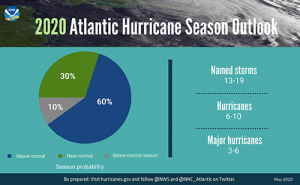
We’re now in the prime of hurricane season. Living in Florida, preparing for possible destructive storms is just part of life. So, it’s important to plan and take steps to protect ourselves, our homes and our landscapes.
This time of year, we need to have a contingency plan against powerful winds and flooding rains. Ornamental trees and shrubs are especially vulnerable.
An important protective measure is to stake and attach guide wires to any recently planted (within 12 months) trees or large shrubs. Although root systems may very well be established, the young roots may not yet have anchoring capacity and could snap under strong winds. Stakes should be 2’-3’ in length. Using three or four stakes and driving them away from the plant at a 45-degree angle for 18” or more should be sufficient. So, how far should the stakes be from a tree? A good practice is to drive the stake approximately the same distance from the base of the tree as the height above ground from where guide wires will be attached.
Studies have shown that 20% of storm damage is caused by trees during hurricane or tropical storm events. Just a cubic foot of pine branch weighs 52 lbs. A branch ten feet in length can deliver as much as one ton of force. Imagine what that can do to a roof! So, check your trees now. Look for signs of weakness, like bark falling off, internal decay, root rot and branching too close to a structure. If a structure is in question, if possible, the tree canopy should be thinned, or the outer edge pruned. Any trees that had roots cut during new home construction is a red flag, also. The tree will most likely fall during a storm event in the future.
As we saw with Hurricane Michael, older trees and pines do not hold up well against major storms. Maple, Live Oak and Elm trees have good wind resistance as they age. Bald Cypress, Crape Myrtle and Dahoon Holly are a few ornamental tree species that also fit the category of resistance.
For more information contact your local county extension office.
UF/IFAS Extension is an Equal Opportunity Institution.
by Ray Bodrey | Aug 10, 2020
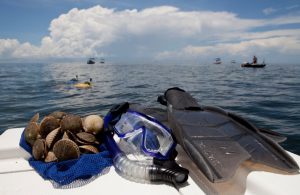
Tuesday, August 11th from 6-7 PM ET
Join us to learn more about recreational scalloping!
Hear from UF/IFAS, Florida Sea Grant, FWC, and FWRI presenters and stay for Q&A.
The pandemic has been challenging, to say the least. We must all must be contentious to all residents and visitors looking forward to spending some good quality time on the bay. The 2020 recreational scalloping season is set to take place August 16th – Sept. 24th for St. Joseph Bay and Gulf County. This region includes all state waters from the Mexico Beach Canal in Bay County to the westernmost point of St. Vincent Island in Franklin County.
During this event, UF/IFAS Extension & Florida Sea Grant Agents, along with Florida Fish and Wildlife Conservation Commission will give updates and hold Q & A about the status of scallop populations in the area and the ongoing monitoring projects. There will also be information presented regarding regulations, as well as boat safety reminders so that everyone will have a safe trip out of the water this season!
Join us to learn more about recreational scalloping! Don’t miss out!
This event is free, but you must register here: https://www.facebook.com/events/329876454812541/
For more information, contact Gulf County Extension at 639-3200 or email at rbodrey@ufl.edu. *Due to COVID-19, our physical office location is closed to public traffic at this time. However, please call or email us for assistance with extension related needs. Sorry for the inconvenience.
UF/IFAS Extension is an Equal Opportunity Institution.
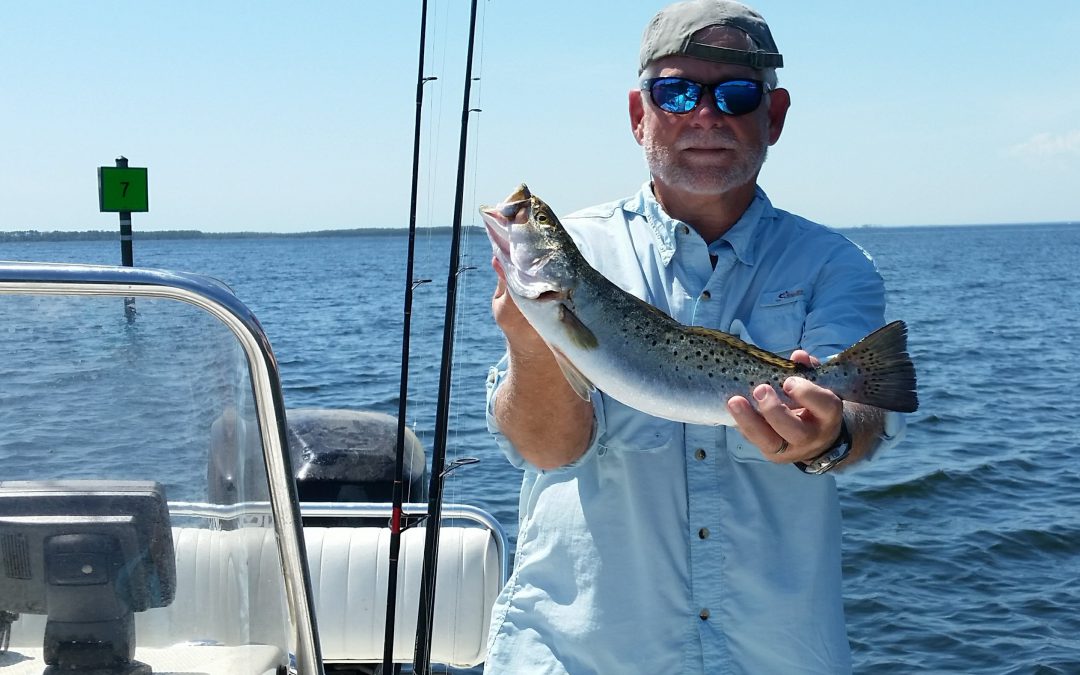
by Mark Mauldin | Feb 28, 2020
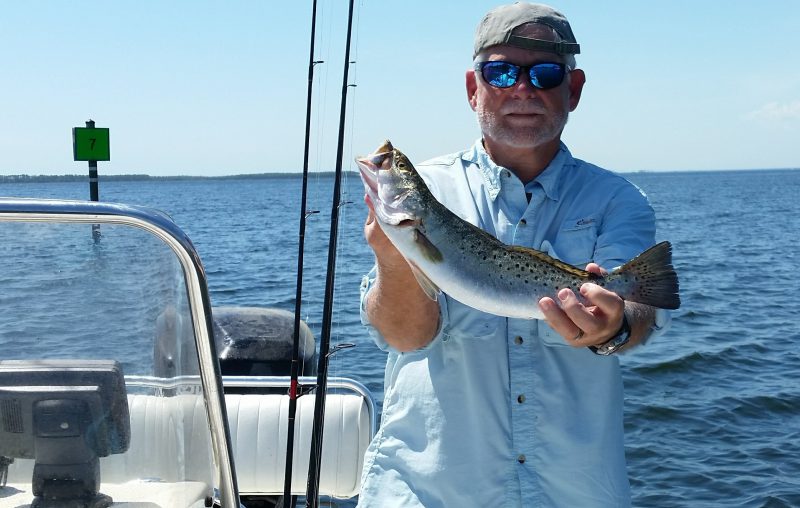
A spotted seatrout caught last summer in the St. Andrew’s Bay system (an area now included in the new Western Panhandle Management Zone).
Photo credit: Mark Mauldin
Recently FWC (Florida Fish & Wildlife Conservation Commission) announced rule changes relating to spotted seatrout.
The text was taken directly from FWC press releases; details not pertinent to NW Florida were removed.
Several rule changes for spotted seatrout [went] into effect Feb. 1, including a closure to spotted seatrout harvest in the new Western Panhandle management zone. Spotted seatrout are one of Florida’s most popular inshore fisheries. The Florida Fish and Wildlife Conservation Commission (FWC) made these changes after reviewing the results of a recent stock assessment and gathering input from anglers. These changes were made to benefit spotted seatrout populations while continuing to provide quality fishing opportunities.
The following rules [went] into effect Feb. 1, 2020:
- Creating two new zones by splitting the Northwest spotted seatrout management zone into the: (See maps below.)
- Western Panhandle (Escambia County through the portions of Gulf County west of longitude 85 degrees, 13.76 minutes but NOT including Indian Pass/Indian Lagoon).
- Big Bend (remaining portion of Gulf County plus Indian Lagoon, and Franklin County through Fred Howard Park Causeway in Pinellas County).
- Reducing bag limits
- Western Panhandle: three fish (was five).
- Big Bend: five fish (no change).
- Modifying the recreational slot size limit from 15-to-20 inches to 15-to-19 inches total length.
- Allowing one seatrout over 19 inches per vessel (currently per harvester).
- Prohibiting captain and crew from keeping a bag limit on a for-hire trip.
- Re-establishing the February recreational closure in the Western Panhandle zone.
Learn more about spotted seatrout by visiting MyFWC.com/Marine and clicking on “Recreational Regulations” and “Spotted Seatrout.”
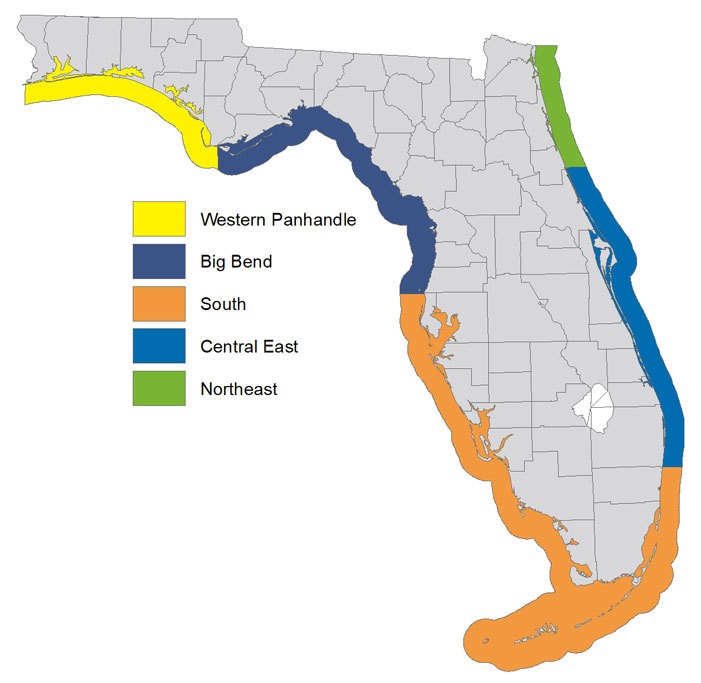
Newly-approved FWC Spotted seatraout management zones, effective February 1, 2020
Image source: www.myfwc.com
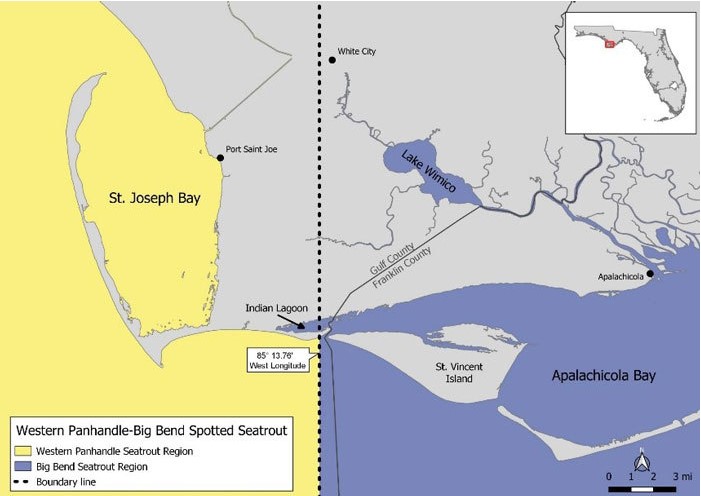
New boundary between the Western Panhandle and Big Bend spotted seatrout management zones effective Feb. 1, 2020.
Image source: www.myfwc.com
Earlier this week Governor DeSantis announced the dates for the 2020 Gulf Red Snapper Season – June 11 through July 25.
Governor Ron DeSantis Announces 2020 Gulf Red Snapper Season
Tallahassee, Fla. – Today, Governor Ron DeSantis announced the popular 2020 Gulf red snapper recreational season is set to open June 11 through July 25, with a possible fall reopening if quota is available. This season will apply to those fishing from private recreational vessels in Gulf state and federal waters, and to charter vessels that do not have a federal reef fish permit and are limited to fishing in state waters only.
Earlier this month, Florida was delegated authority to manage recreational red snapper harvest from private vessels in Gulf federal waters.
“I’m pleased to announce that our state’s good conservation practices are allowing us to have a 45-day Gulf red snapper season this year,” said Governor DeSantis. “Gulf red snapper season is always an exciting time for anglers and is just another reason why Florida remains the Fishing Capital of the World.”
“Gulf red snapper is a conservation and management success story for Florida anglers,” said Florida Fish and Wildlife Conservation Commission (FWC) chairman Robert Spottswood. “Just a few years ago, a 45-day season for red snapper in both state and federal waters was out of reach. Thank you to all the stakeholders and anglers who helped make this season possible by providing input and sharing information about their fishing trips.”
“FWC is proud to be able to work with our stakeholders to balance conservation with fishing opportunities for Gulf red snapper and we are excited to see what the future holds as FWC takes the unprecedented step of managing this resource in both state and federal waters of the Gulf,” said Spottswood.
For more on recreational snapper regulations, visit MyFWC.com/Marine and click on “Recreational Regulations” and “Snapper” under the “Reef Fish” tab.
Follow the link for more information on Snapper fishing in Florida – FWC Snappers
by Ray Bodrey | May 7, 2018
It’s a struggle to manage our Panhandle landscapes, especially over the late spring-summer months. Just remember, small adjustments can mean significant impacts in conserving water.
Some homeowners are not aware that watering plants too much can have as much of an ill effect as not watering enough. Shallow rooted plants, as well as newly set plants can easily become water stressed. Some people lightly water their plants each day. With this practice, one is only watering an inch or less of the topsoil. Most plant roots are deeper than this. Instead of a light watering every day, soaking the plant a few times a week is best. A soil that has been soaked will retain moisture for several days. This is a very good practice for young plants. In contrast, some people soak their plants to often. This essential drowns the roots by eliminating vital oxygen in the root zone. This can also cause root rot. Signs of overwatering are where leaves turn brown at the tips or edges, as well as leaf drop.
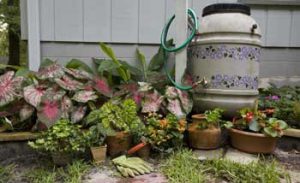
Figure 1: Rain Barrel.
Credit: UF/IFAS Florida-Friendly Landscaping.
The following are tips from the UF/IFAS Florida-Friendly Landscape Program. These tips will help you conserve water and provides best management practices for your landscape.
- Choose the right plant for the right place: Be sure to place plants in your landscape that match conditions with plant needs.
- Water Thoughtfully: Of course, follow water restrictions first and foremost. Water early in the morning and water when plants and turfgrass start to wilt. Refrain from watering in the late afternoon or evening. This is when insects and diseases are most active.
- Perform regular irrigation maintenance: Remember, an irrigation system is only effective if it is maintained regularly. Check for and repair leaks. If using a pop-up heads for turfgrass, point heads away from driveways and sidewalks.
- Calibrate turfgrass irrigation system: Ideal amount of water to apply to turfgrass is ½”- ¾”. A simple test can be done to calibrate. Place a coffee or tuna cans throughout the landscape. Run the irrigation system for 30 minutes. Average the depth of the water containers. Adjust running time to apply the ½”- ¾” rate.
- Use microirrigation in gardens and individual plants: Drip or microspray irrigation systems apply water directly to the root system with limited surface evaporation.
- Make a rain barrel: Rain barrels are an inexpensive way to capture rainwater from your roof. This can translate into a big impact on your water bill as well.
- Mulch plants: Mulch helps keep moisture in the root zone. Two to three inches in depth, for a few feet in diameter will work well for trees, shrubs, flowers and vegetables.
- Mow correctly: Mowing your grass at the highest recommended length is key. Be sure to cut no more than 1/3 of the leaf blade each time you mow. Keep mowing blades sharp as dull cuts often cause grass to be prone to disease.
- Be a weather watcher: Wait at least 24 hours after a rainfall event to water. If rain is in the forecast, wait 48 hours until irrigating. Use a rain gauge or install a rain shut-off device to monitor irrigation scheduling.
Following these tips will help you conserve water and maximize watering efforts in your landscape. For more information on water conservation principles please contact your local county extension office.
Supporting information can be found at the UF/IFAS Center for Landscape Conservation & Ecology’s Drought Toolkit: http://clce.ifas.ufl.edu/drought_toolkit/
UF/IFAS Extension is an Equal Opportunity Institution.
by Laura Tiu | Apr 14, 2018
Spring has sprung and it is time to get outside and explore this great Florida Panhandle area. In neighboring Santa Rosa County, a terrific destination for a variety of outdoor activities is Blackwater River State Park. Visitors can canoe, kayak, tube, fish and swim the river. Hikers can enjoy trails through nearly 600 acres of undisturbed natural communities. Bring a picnic and hang out at one of several pavilions or white sand beaches that dot the river (restroom facilities available). Near the pavilions, stop and see one of the largest and oldest Atlantic white cedars, recognized as a Florida Champion tree in 1982. The park also offers 30 campsites for tents and RVs. Park entry is $4.00 per car, payable at the ranger station or via the honor system (bring exact change, please).
The Blackwater River is considered one of the purest and pristine sand-bottom rivers in the world. The water is tea-colored from the tannins and organic matter that color the water as it weaves through the predominantly pine forest. The river is shallow with a beautiful white sandy bottom, a nice feature for those tubing or paddling the trail. The river flows for over 50 miles and is designated as a Florida canoe trail. Multiple small sand beach areas line the river and provide plenty of space to hang out, picnic, or throw a Frisbee. Blackwater eventually flows into Pensacola Bay and the Gulf of Mexico bringing high quality freshwater into this important estuary.
A favorite trail in the Park is the Chain of Lakes Nature Trail. Parking for this 1.75 mile loop trail is at South Bridge on Deaton Bridge Road. The trail head is well marked and has a boardwalk that leads into the floodplain forest. The trail winds through a chain of shallow oxbow lakes and swamp that dot the former route of the river. If you are lucky and it is a clear, blue-sky day, you may see a beautiful rainbow effect as the sun hits the water. We call this the pastel swamp rainbow effect. This is a result of the natural oils from the cypress cones settling on the surface of the water and associated trapped pollen.
The trail then turns to sneak through the sandhill community in the park with giant longleaf pines, wiregrass and turkey oak. Evidence of prescribed burning shows management efforts to maintain the forest. Cinnamon ferns, bamboo and other natives appear in pockets along the trail. The trail in this section is blanketed with a mosaic of exposed root systems, so be careful as you step. Finally, pack some bug spray and a water bottle for this fun hike.
For more information, visit the park page: https://www.floridastateparks.org/park/Blackwater-River
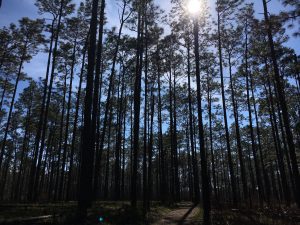
Sandhill pine forest at Blackwater River State Park
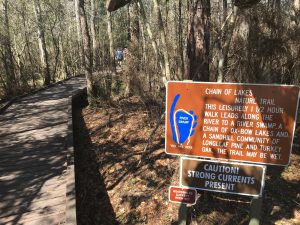
2737 – Chain of Lakes trailhead at Blackwater River State Park
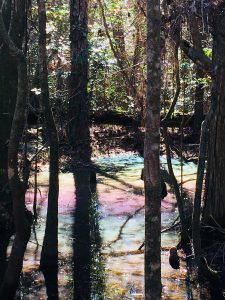
“Rainbow Swamp” on the Chain of Lakes trail at Blackwater River State Park
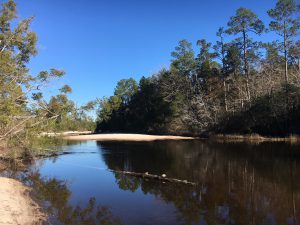
Beautiful sandy beaches along the Blackwater River in the State Park.
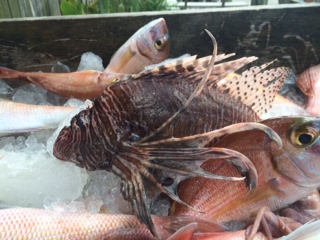
by Rick O'Connor | Feb 28, 2018
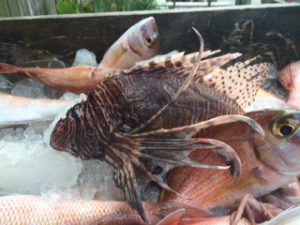
Lionfish caught on rod and reel. Photo Credit: Alison Rogers
Since the first lionfish was spotted off Pensacola in 2010, panhandle organizations have been busy trying to control the spread of this invasive species. The story is well known to many… the lionfish is a voracious predator, consuming at least 70 different species of small reef fish, including vermillion snapper. They reproduce frequently, producing an average of 25,000 eggs/female every four days – and they breed during most of the year. The densities of these fish on our nearshore and offshore reefs are some of the highest in the South Atlantic region, and they prefer artificial reefs to natural bottom. We know they have spread across the northern Gulf to include all five Gulf states and are found in Mexican waters.
We also know that the primary method of removal is still spearfishing. The state of Florida has an open season on them and provides a program to assist local divers with selling their harvest. There are several rodeo tournaments along the Gulf coast and some traditional fishing tournaments have created a category for them. Education programs about the problem continue and some restaurants have offered them when they can get them.
So how are things going?
Are we on top of controlling the lionfish?
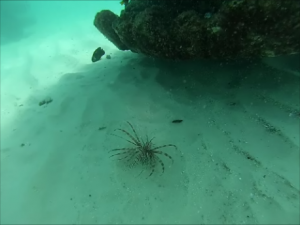
Lionfish at Pensacola Beach Snorkel Reef. Photo Credit: Robert Turpin
Anecdotal reports suggest we have made some impact. Local divers in the Pensacola area report that the shallower public reefs frequented by local divers and dive charters have indicated they are getting harder to find. There have been some tour trips, taking out of town residents diving for lionfish, where they have had to really search to find them. This is certainly encouraging and a numerical assessment of this is needed. However, there are also reports of charter fishing boats catching them on hook and line in deeper waters. They are not catching many, but they do occasionally grab them. When they do, it is usually on live bait and in deep water, 200 feet or so. Local divers seem to agree with this. They too find more lionfish, and some large ones, at depth – too deep to take a typical dive charter trip to remove.
Recent research has shown that lionfish are able, at least in the northern Gulf of Mexico, to swim greater distances than once thought to re-colonize reefs that have been cleaned. One study showed that selected artificial reefs, which were completely cleaned of lionfish, had restored lionfish populations, both young and old fish, within a year. This same study suggests that to keep lionfish at relatively low-density (about 5 lionfish/100 m 2) reefs would need to be cleaned every two months.
Several lionfish derbies occur along the Florida panhandle, but not at the frequency that may be needed to control re-colonization of shallower reefs by lionfish from deeper ones.
Can we increase the number of derbies?
Sure… but those who work on these derbies know the time and financial commitment required to put one on. It could happen that the number of local derbies would increase but we may have to think of other means of controlling lionfish.
One idea is to increase the number who harvest commercially. To do so a diver would need to acquire a saltwater products license from the Florida Fish and Wildlife Conservation Commission (FWC). On their website, they provide the application and a list of approved buyers for the diver to contact. http://www.myfwc.com/Lionfish.
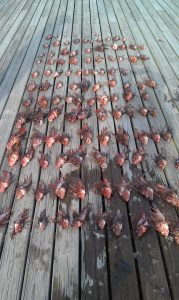
Harvested lionfish. Photo Credit: Bryan Clark
One drawback to the commercial idea is the price. Currently divers require a high price for their catch in order to cover cost and show a profit. These high prices equate to high prices at local restaurants, higher than the public may be willing to pay. One unpublished study shows that some locals are willing to pay more for a lionfish dinner if they know it is helping the environment. Many seafood lovers understand the high cost of lobster, but have not placed lionfish in the same category and are not as willing to pay higher prices; this may have to change. Research continues on developing a lionfish trap that has low by-catch rates. If an effective trap is developed, they could be deployed from vessels, which would not require diving, and could bring prices down.
There is evidence that populations of small reef fish have significantly declined since 2010. Whether this was due to the oil spill, the lionfish invasion, or a combination is still not certain. It is known that local reefs that are cleaned of lionfish are repopulated with both large and small lionfish. We have had some success with removing but we still have work to do.
Reference
Dahl, K.A., W.F. Patterson, R.A. Snyder. 2016. Experimental Assessment of Lionfish Removals to Mitigate Reef Community Shifts on Northern Gulf of Mexico Artificial Reefs. Marine Ecology Progress Series. Vol 558. Pp: 207-221.















